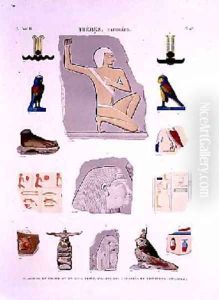Lenoir Paintings
Charles-Amable Lenoir was a French painter, born in 1844 in Châtelaillon, France. Lenoir's artistry was deeply influenced by the academic and romantic traditions of the 19th century, particularly by the works of William-Adolphe Bouguereau, under whom he studied. His education at the École des Beaux-Arts in Paris laid a solid foundation for his classical techniques and compositional skills. Lenoir's oeuvre primarily encompasses portraits, landscapes, and mythological themes, executed with a delicate and refined touch that characterizes the academic art movement.
Throughout his career, Lenoir achieved significant recognition and success. He was a frequent participant in the Paris Salon, the prestigious art exhibition of the Académie des Beaux-Arts in Paris, where he won several medals for his exquisite paintings. His works were celebrated for their beauty, attention to detail, and the ethereal quality of his figures. Lenoir's paintings often depicted women in idyllic and serene settings, embodying the idealized beauty and romanticism that were popular in the late 19th and early 20th centuries.
Despite his success, Charles-Amable Lenoir's work, like many of his contemporaries in the academic art tradition, was later overshadowed by the rise of modernist movements. However, in recent years, there has been a renewed interest in Lenoir and his contributions to French art. His paintings are now appreciated not only for their technical mastery but also for their historical significance in the continuum of French painting.
Lenoir's dedication to the principles of beauty and harmony, as espoused by the academic art movement, remained steadfast throughout his life. He passed away in 1924, leaving behind a legacy that, after years of relative obscurity, has begun to be re-evaluated and celebrated anew in the context of art history. Today, Charles-Amable Lenoir is regarded as an important figure in the panorama of French academic painting, his works offering a window into the aesthetic values and cultural aspirations of his time.
